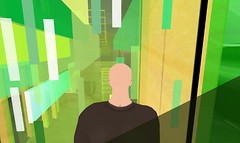Vegas and Videogames: More, More, More
 Like a lot of people, I spent a lot of my summer in pursuit of leisure. And like a lot of people I visted Las Vegas.
Like a lot of people, I spent a lot of my summer in pursuit of leisure. And like a lot of people I visted Las Vegas.
Dipping my toe into that bacchanal of excess, I noticed a display in one of the many opulent bastions of conspicuous consumption that are the Forum Shops at Ceaser’s Palance. A window display inside Dolce & Gabbana featured a towering pile of faux leapord skin purses. Like pyramids of skulls built on battlefields to remind the enemy of your power, your absolute ability to dominate and create a tribute to excessive force and violence. the purse pyramid was a becon of Vegas’ consumerism: See, we have so much crap we can just pile up expensive handbags.
 I could leave this as some sort of hand-handed capitalist parable. But what really got me thinking was that, in fact, while this is a very obvious illustration of the excess of Western Capital Culture, it is also a pretty good example of something that’s been bugging me about videogames.
I could leave this as some sort of hand-handed capitalist parable. But what really got me thinking was that, in fact, while this is a very obvious illustration of the excess of Western Capital Culture, it is also a pretty good example of something that’s been bugging me about videogames.
In the virtual world, a pile of purses consumes the same resources as a pile of rocks, or a tower built of Tiffany Crystal. So, videogames have created an inside-out view of materiality.
On one hand, games without a lot of stuff feel empty. For most of us, slaying one monster from hell would be enough for a lifetime of bragging. In games, we have to mow down thousands of Nazis to feel like we have our money’s worth. MMOs have become fashion runways where more is better, and more exotic is best. Game quality can be measured on one axis by the number of textures (read simulated materials) the game has at its disposal.
On the other hand, we have started to loose the sense that things matter. More dead enemies, more options at the local armorer’s shoppe–it’s all a blur. Videogame’s casual treatment of matter bleeds into our real world perceptions until it doesn’t shock us to see a lot of anything. We’re used to it.
The computer’s ability to dematerialize excess and make excessive the material is one of those frontiers where the digital medium and the material world, synthetic places and real spaces, interface. In this liminal space, the real and the virtual coexist, and window display works as well as an advertisement as it does a place in Second Life.
Debord and Dubai

This piece is a few years old, but after spending some time reading Debord this spring, I thought this quote was worth underlining:
Sand and freedom | | Guardian Unlimited Arts
This is the type of empty, rootless scenario that Guy Debord’s Society of the Spectacle and Rem Koolhaas’ Generic City warned us about – but then, what else should a 21st-century Arab city look like?
If you havn’t read The Society of the Spectacle, it’s worth the time. Even though it’s steeped in the sort of Marixism that we so quickly look down on these days, when read through the context of architecture and videogames, it’s hard to pause. Consider this opening bit:
In societies dominated by modern conditions of production, life is presented as an immense accumulation of spectacles. Everything that was directly lived has receded into a representation.
Or this:
The images detached from every aspect of life merge into a common stream in which the unity of that life can no longer be recovered. Fragmented views of reality regroup themselves into a new unity as a separate pseudoworld that can only be looked at. The specialization of images of the world evolves into a world of autonomized images where even the deceivers are deceived. The spectacle is a concrete inversion of life, an autonomous movement of the nonliving.
And that’s just the first to paragraphs in the book!
When applied to the urban development in Dubai, you don’t have to have a copy of the Communist Manefesto on your self to get something out of the insight.
